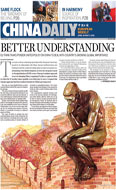Society
China may send women to space in 2012
Updated: 2011-05-01 09:18
By Xin Dingding (China Daily)
Female astronauts could be part of Shenzhou missions in late 2012
BEIJING - China's women astronauts may fly to space as soon as the latter half of next year, said a senior official in charge of the manned space program on Friday.
 Yang Liwei, deputy director of the China Manned Space Engineering Office, said that following the country's first unmanned rendezvous and docking mission between the space module Tiangong-1 and an unmanned spacecraft Shenzhou VIII later this year, two more Shenzhou spacecraft will blast off next year to improve the rendezvous and docking technologies.
Yang Liwei, deputy director of the China Manned Space Engineering Office, said that following the country's first unmanned rendezvous and docking mission between the space module Tiangong-1 and an unmanned spacecraft Shenzhou VIII later this year, two more Shenzhou spacecraft will blast off next year to improve the rendezvous and docking technologies.
At least one of the two spacecraft next year will be manned, said Yang, who is also China's first astronaut to space.
"Two to three astronauts will be sent to space in that manned mission next year," he said, without elaborating.
| ||||
But Yang said that there are possibilities for the women to join next year's mission.
The two women astronauts, both pilots from the People's Liberation Army Air Force, are the first women astronauts in China.
The 14 astronauts in the first batch, who were recruited in 1997, are all men, including Yang and Fei. So far, six of them have flown into space in three different missions.
Yang and Fei introduced China's manned space programs to 56 overseas reporters on Friday at the "space town" in the northern Beijing suburb, where astronauts are trained. They were joined by Chen Shanguang, director of the Astronaut Center of China.
Reporters were also shown three spacecraft simulators built for astronaut training, including a copy of Tiangong-1, a docking-platform spacecraft that will be launched in the latter half of this year to make the first unmanned rendezvous and docking mission with Shenzhou VIII, which will be launched later.
Yang also revealed on Friday that China spent some 20 billion yuan ($3 billion) on the first stage of the manned space program.
The first stage's goal was to launch a manned spacecraft, which succeeded with the launch and return of Shenzhou V with Yang Liwei on board in 2003.
The second step is to make technology breakthrough in extravehicular activities as well as space rendezvous and docking of spacecrafts. It also includes the launch of a space lab and finding solutions for astronauts to make short-term stays in space. The extravehicular activities were completed in 2008 as astronaut Zhai Zhigang did a space walk out of Shenzhou VII spacecraft.
The third step is to establish a space station where astronauts will stay for long periods. Last week, China Manned Space Engineering Office has announced its plan of building a 60-ton space station and asked the public to help come up with a resonant name and logo for the space station.
"As the future missions will be more complicated than the first step, the government investment in the program will grow along," Yang said, without giving a number.
"In the coming Shenzhou VIII mission, China and Germany will jointly carry out a biological cultivation experiment in the spacecraft," he said, adding China and France are also discussing carrying out experiments in China's space lab.
E-paper

Head on
Chinese household care goods producers eye big cities, once stronghold of multinational players
Carving out a spot
Back onto center stage
The Chinese recipe
Specials

British Royal Wedding
Full coverage of the royal wedding of Prince William and Kate Middleton in London. Best wishes

The final frontier
Xinjiang is a mysterious land of extremes that never falls to fascinate.

Bridging the gap
Tsinghua University attracts a cohort of foreign students wanting to come to China.




